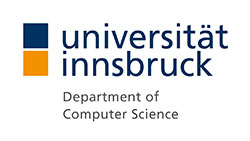We make the measurability of our R&D results one of our primary tasks. We want to show to the world that semantic technologies are becoming reality. Find out more about our results and our spin-off companies.
RuleML and DERI Collaborate on Rules and Services Technologies Based on Their Standardization Initiatives
RuleML, the leading provider of standards for rules technologies on the Web and in distributed platforms, and DERI (Digital Enterprise Research Institute), the leading European effort in Semantic Web Services that spearheads the Web Services Modeling Ontology (WSMO) working group, today announced the formation of a collaborative effort on integrating their platforms to enhance support for rules and services technologies. This collaboration explores the deployment and extension of the RuleML family of languages to integrate with the WSMO platform, focusing on rules and services interoperability on top of RuleML and WSML, WSMO's Language component. Anticipated benefits of this integration include that WSMO will take advantage of the modular flexibility and tools available in RuleML, and RuleML will be able to support the WSMO services modeling requirements.
RuleML is about rule interoperation between commercially important families of rule systems (including Production Rules, Relational and XML Databases, Event-Condition-Action Rules, Prolog, and others), as well as between industry standards relevant to rules (such as in the Semantic Web, XML, Web Services, Web Service Discovery, Web Service Composition, and Web Service Choreography, Business Processes, Privacy, Security, as well as Software Modeling and Interface Specifications).
WSMO describes various aspects of Semantic Web Services to decrease the need for human intervention for making heterogeneous components interoperable. It enables automatic Service discovery, composition, mediation and invocation. WSMO seeks to create a standard featuring simplicity (a solution to the integration problem that is as simple as possible), completeness (solves all aspects of the integration problem), and executability (a set of execution semantics exists as well as a reference implementation). It is being developed together with industrial as well as academic partners, and in alignment with various research projects.
Contact person in charge.

